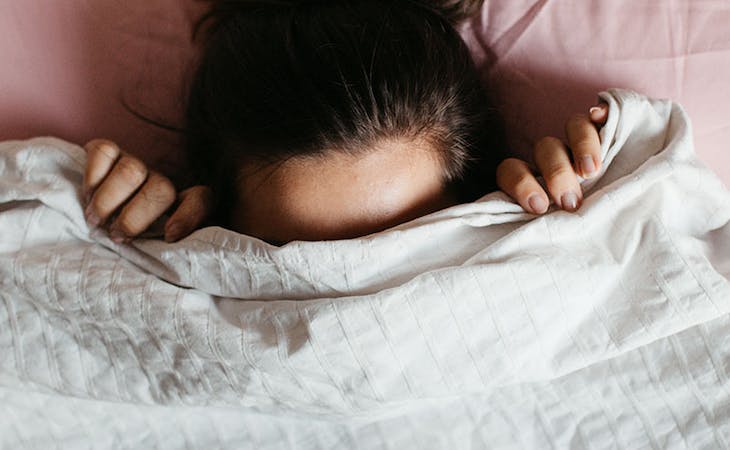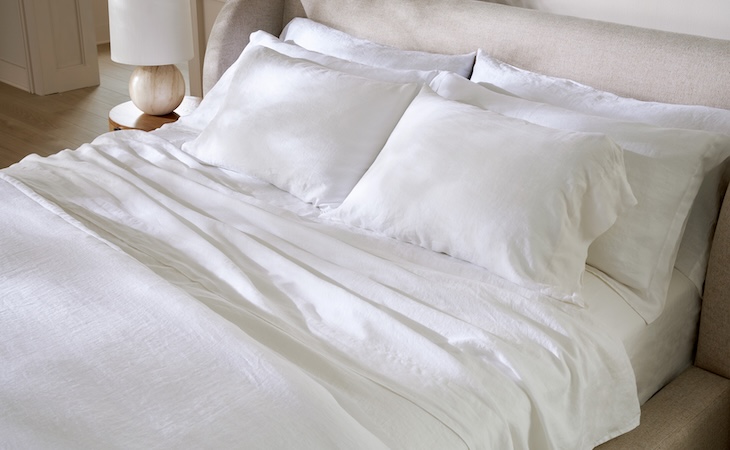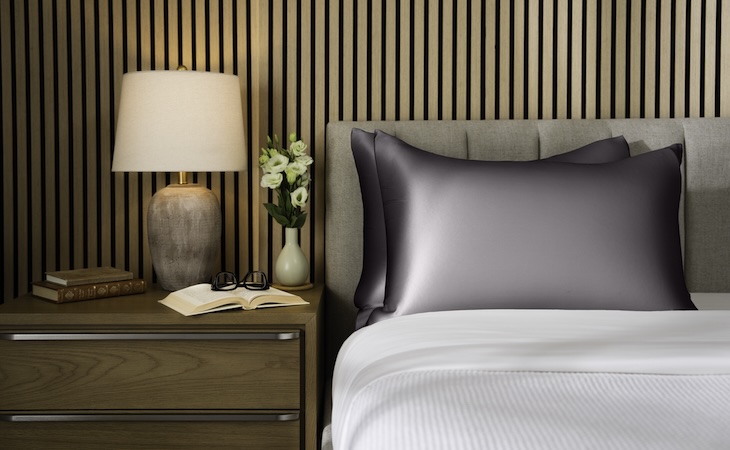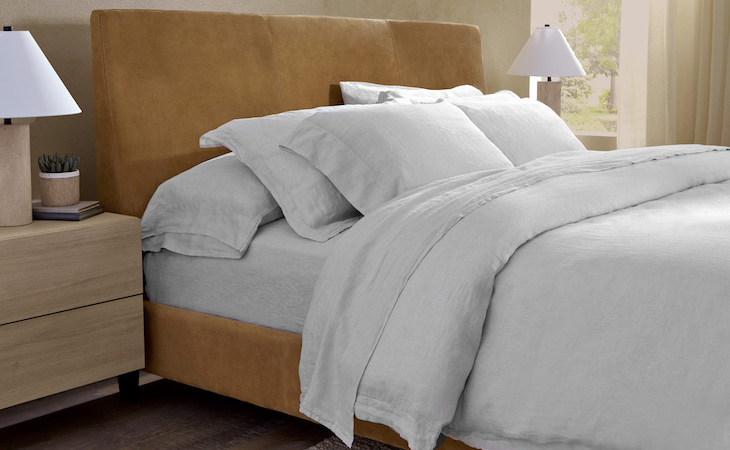If you’re prone to acne, then you know keeping your skin free of breakouts is a daily battle. Frequent dermatologist visits, avoiding overly greasy skin care products, and eating a healthy, balanced diet are all essential steps in the fight against zits—but sometimes that’s not enough to keep your complexion clear. [3, 4]
Choosing the right bedding is also important for your skin health. That’s because your bed sheets could actually be causing breakouts, especially if you have acne-prone skin.
How can you keep your bed sheets from flaring up your skin conditions? We’re going to explore the top bed sheet materials to select for acne-prone skin, as well as some of the worst.
What type of sheets is best for acne?
Finding bed sheets that don’t cause acne breakouts and flare up other skin conditions like eczema can be difficult. However, there are quite a few bed sheet materials you can choose to help reduce your breakouts and skin issues.
The best sheets for acne-prone skin are made from natural antimicrobial fibers. [5, 6] These include:
- Silk
- Cotton
- Bamboo
Silk sheets
Silk is a soft, natural fiber and is a great option for bed sheets if you have acne-prone skin. [6] Silk sheets don’t absorb moisture or products, meaning they won’t clog pores. Silk is also naturally antibacterial. [6]
One downside—silk sheets are a little tricky to care for. If you’re looking for a more low-maintenance sheet set, it may be better to opt for a different natural fiber.
The best way to care for silk sheets is by washing them with a gentle detergent, separately from the rest of your laundry. Make sure to put them in a mesh laundry bag in both the washer and dryer. This will ensure your silk sheet set remains durable and soft throughout its lifespan.
Cotton sheets
Cotton is another great natural fiber you can opt for if you have acne-prone skin. [7] These sheets are durable, machine washable, and have been a staple in the bedding industry for a long time. Cotton sheets tend to come in one of two weaves: percale or sateen.
For acne-prone skin, sateen sheets are the better option. They tend to feel more silky and smooth against the skin and won’t irritate any other skin conditions you may have. Look for a sateen sheet set with a thread count between 300 and 600. This will ensure your sheets are ultra-soft, silky, and non-irritating.
When buying cotton sheets, avoid sets that use harmful chemicals, like bleach or other dyes, during production. These could potentially irritate any skin conditions you might have.
Bamboo sheets
People don’t commonly think of bamboo when it comes to bed sheets, but it’s a breathable, natural fiber that works well for acne-prone skin. Bamboo sheets have the added benefit of being antibacterial, antimicrobial, and hypoallergenic. [8]
Bamboo is also one of the most eco-friendly and sustainable fabrics available for bed sheets, which is great for environmentally-conscious shoppers.
Bed sheet fabrics to avoid if you have acne-prone skin
If you frequently suffer from unwanted breakouts, you should look for sheets that are light, breathable, and antibacterial. However, there are also a few bed sheet fabrics you should avoid. These include:
- Flannel
- Fleece
- Microfiber
- Wool
All of these materials tend to trap heat, bacteria, and other harmful germs. Even though you may be tempted to reach for these sheets during the colder months, you should still opt for a more breathable option for the sake of your skin. [9]
Other best practices to avoid irritating your skin with bed sheets
When it comes to your bed sheets, selecting the right material isn’t the only thing you can do to help improve your skin health. There are also quite a few best practices you can adopt in your daily life that can help reduce breakouts and acne flare-ups.
Wash your sheets frequently
Changing your sheets is probably something you don’t do frequently enough. While it may not have any negative consequences for those blessed with naturally clear skin, people with acne-prone skin will want to wash their sheets more frequently.
Ideally, people with acne-prone skin should wash their sheets at least once a week, if not more. Studies have even shown that our pillowcases and bedsheets may harbor large quantities of fungi and/or bacteria. [10,11] If you suffer from acne, you can even throw your pillow in the dryer for 15 minutes every few days so the heat kills any bacteria on the surface. [12]
While most sheets come with instructions to wash with cold water for long-lasting durability, hot water is best for killing bacteria. [12] If you decide to wash your sheets in cold water, make sure to toss them in the dryer afterward to kill the bacteria that survived the wash. [12]
You’ll also want to ensure your laundry detergent and fabric softeners are free of fragrance and dyes that could irritate your skin. [13, 14]
Think about your pillowcase material
We’ve already gone over the best and worst materials for your bed sheets—but your pillowcase material might be even more important. You should always opt for a natural fiber that’s breathable, light, and smooth.
Our number one recommendation is to use silk pillowcases, which can help prevent both wrinkles and breakouts. Although silk doesn’t absorb moisture as well as cotton, it still does a good job of repelling dust mites, mold, and bacteria due to its natural protein structure. [6, 14]
You can always opt for cotton pillowcases if you’re a hot sleeper looking for something more absorbent. Cotton offers great airflow and moisture-wicking properties.
Stick to a nightly face-washing routine
If you’re bringing all the dirt you’ve accumulated on the surface of your skin during the day into your bed, you’re pretty much guaranteed to wake up with a pimple. So make sure to stick to a consistent skincare routine each night before getting your beauty sleep. [3]
And while you’re at it, take a nightly bath too—not only will it relax you for sleep, but it will also help keep body breakouts at bay.
FAQs
Is my blanket giving me acne?
If you use a blanket that’s made of a material that traps heat, bacteria, and other harmful germs (like wool, fleece, or flannel), and you don’t wash it frequently, then it may be giving you acne. [9]
Does changing bed sheets help with acne?
Changing bed sheets can help with acne as it’s unhygienic to sleep on the same sheets for a long period due to sweat accumulation. [10, 11]
Finding the best sheets for your skin with Saatva
Whether you’re dealing with acne, sensitive skin, or allergies, it’s important to pick a sheet set that won’t cause further skin irritation. Learn how to choose the best sheets for your biggest skin concerns.
Additionally, check out Saatva’s collection of high-quality bed sheets. Our sheets are curated with your comfort in mind. They’re some of the softest on the market and perfect for people with acne or sensitive skin.
References
- Gulati R, Sharma S, Sharma RK. Antimicrobial textile: recent developments and functional perspective. Polym Bull (Berl). 2022;79(8):5747-5771. doi:10.1007/s00289-021-03826-3
- Del Rosso JQ. The role of skin care as an integral component in the management of acne vulgaris: part 1: the importance of cleanser and moisturizer ingredients, design, and product selection. J Clin Aesthet Dermatol. 2013;6(12):19-27.
- Leung AK, Barankin B, Lam JM, Leong KF, Hon KL. Dermatology: how to manage acne vulgaris. Drugs Context. 2021;10:2021-8-6. Published 2021 Oct 11. doi:10.7573/dic.2021-8-6
- Dall’Oglio F, Nasca MR, Fiorentini F, Micali G. Diet and acne: review of the evidence from 2009 to 2020. Int J Dermatol. 2021;60(6):672-685. doi:10.1111/ijd.15390
- Brambilla L, Brena M, Tourlaki A. Textiles in dermatology: our experience and literature review. G Ital Dermatol Venereol. 2016;151(3):266-274.
- Schaunig C, Kopera D. Silk textile with antimicrobial AEM5772/5 (Dermasilk): a pilot study with positive influence on acne vulgaris on the back. Int J Dermatol. 2017;56(5):589-591. doi:10.1111/ijd.13541
- Granados A, Pleixats R, Vallribera A. Recent Advances on Antimicrobial and Anti-Inflammatory Cotton Fabrics Containing Nanostructures. Molecules. 2021;26(10):3008. Published 2021 May 18. doi:10.3390/molecules26103008
- Ramful R, Sunthar TPM, Kamei K, Pezzotti G. Investigating the Antibacterial Characteristics of Japanese Bamboo. Antibiotics (Basel). 2022;11(5):569. Published 2022 Apr 24. doi:10.3390/antibiotics11050569
- Broadhead R, Craeye L, Callewaert C. The Future of Functional Clothing for an Improved Skin and Textile Microbiome Relationship. Microorganisms. 2021;9(6):1192. Published 2021 May 31. doi:10.3390/microorganisms9061192
- Woodcock AA, Steel N, Moore CB, Howard SJ, Custovic A, Denning DW. Fungal contamination of bedding. Allergy. 2006;61(1):140-142. doi:10.1111/j.1398-9995.2005.00941.x
- Chowdhury D, Tahir S, Legge M, et al. Transmission of dry surface biofilm (DSB) by and through cotton bed sheets. Infection, Disease and Health. 2017;22:S19. doi:10.1016/j.idh.2017.09.078
- Abney SE, Ijaz MK, McKinney J, Gerba CP. Laundry Hygiene and Odor Control: State of the Science. Appl Environ Microbiol. 2021;87(14):e0300220. doi:10.1128/AEM.03002-20
- van Amerongen CCA, Ofenloch RF, Cazzaniga S, et al. Skin exposure to scented products used in daily life and fragrance contact allergy in the European general population – The EDEN Fragrance Study. Contact Dermatitis. 2021;84(6):385-394. doi:10.1111/cod.13807
- Balabanova M, Popova L, Tchipeva R. Dyes in dermatology. Clin Dermatol. 2003;21(1):2-6. doi:10.1016/s0738-081x(02)00330-9Mazurek Ł, Szudzik M, Rybka M, Konop M. Silk Fibroin Biomaterials and Their Beneficial Role in Skin Wound Healing. Biomolecules. 2022;12(12):1852. Published 2022 Dec 12. doi:10.3390/biom12121852




